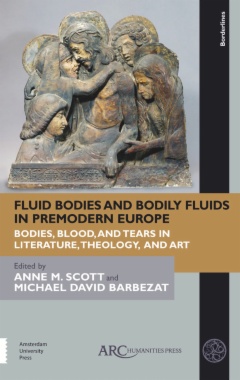This interdisciplinary collection of essays, containing chapters from specialists in history, art history, medical history, and literature, examines how the intimately familiar language of the body served as a convenient medium through which to imagine and describe transformations of the larger world, both for the better and also for the worse. Its individual contributors demonstrate the myriad ways in which rethinking the human body was one way to approach rethinking the social, political, and religious realities of the world from the Middle Ages until the early modern period.
- Cover�������������������������������
- Title page
- Half-title����������������������������������������������
- Series Information����������������������������������������������������������������������
- Title page
- Dedication����������������������������������������������
- Copyright information
- Table of contents
- List of Illustrations
- Chapter 1. Introduction: Bodies, Fluidity, and Change
- Transformative and Manipulative Tears
- Identities in Blood
- Bodies and Blood in Life, Death, and Resurrection
- Author Biographies
- Bibliography
- Part 1. Transformative and Manipulative Tears
- Chapter 2. Where Did Margery Kempe Cry?
- “what Aylith Thee, Woman?”����������������������������������������������������������������������������������������������
- For Crying Out Loud�������������������������������������������������������������������������
- “Why Weepest Thou?”
- Conclusion����������������������������������������������
- Abstract����������������������������������������
- Author Biography����������������������������������������������������������������
- Bibliography����������������������������������������������������
- Chapter 3. Elusive Tears: Lamentation and Impassivity in Fifteenth-century Passion Iconography
- A Case of Male Impassivity in an Image of Lamentation�������������������������������������������������������������������������������������������������������������������������������������������������������������������������������
- The Lamentation’s Authorship and the Origins of Its Composition�������������������������������������������������������������������������������������������������������������������������������������������������������������������������������������������������������������
- Lamentation, Impassivity, and Gender in A Range of Passion Images�������������������������������������������������������������������������������������������������������������������������������������������������������������������������������������������������������������������
- Historical Sources For Understanding Images of Lamentation and Impassivity����������������������������������������������������������������������������������������������������������������������������������������������������������������������������������������������������������������������������������������������
- Conclusion����������������������������������������������
- Abstract����������������������������������������
- Author Biography����������������������������������������������������������������
- Bibliography����������������������������������������������������
- Chapter 4. Catherine’s Tears: Diplomatic Corporeality, Affective Performance, and Gender at the Sixteenth-century French Court
- Tears As Political Performance����������������������������������������������������������������������������������������������������������
- Validating Male Political Agency����������������������������������������������������������������������������������������������������������������
- Lacrimal Persuasion�������������������������������������������������������������������������
- Conclusion����������������������������������������������
- Abstract����������������������������������������
- Author Biography����������������������������������������������������������������
- Bibliography����������������������������������������������������
- Part 2. Identities in Blood
- Chapter 5. Piers Plowman and the Blood of Brotherhood
- Corpus Christi—the Body and Blood of Christ�������������������������������������������������������������������������������������������������������������������������������������������������
- Corporeality and Piers Plowman����������������������������������������������������������������������������������������������������������
- Blood in Its Contemporary Context�������������������������������������������������������������������������������������������������������������������
- Blody Bretherne�������������������������������������������������������������
- The Church and the Blood of Christ����������������������������������������������������������������������������������������������������������������������
- Conclusion����������������������������������������������
- Abstract����������������������������������������
- Author Biography����������������������������������������������������������������
- Bibliography����������������������������������������������������
- Chapter 6. Performative Asceticism and Exemplary Effluvia: Blood, Tears, and Rapture in Fourteenth-century German Dominican Lite
- Models For Corporeal Punishment in Dominican Literature�������������������������������������������������������������������������������������������������������������������������������������������������������������������������������������
- Somatic Piety in the Dominican Schwesternbücher and Offenbarungen�������������������������������������������������������������������������������������������������������������������������������������������������������������������������������������������������������������������
- Henry Suso’s Exemplar: Flagellation and Blood As A Hermeneutic of Embodiment����������������������������������������������������������������������������������������������������������������������������������������������������������������������������������������������������������������������������������������������������
- Conclusion����������������������������������������������
- Abstract����������������������������������������
- Author Biography����������������������������������������������������������������
- Bibliography����������������������������������������������������
- Chapter 7. “bloody Business”: Passions and Regulation of Sanguinity in William Shakespeare’s Macbeth and King Lear
- Passions and Emotional Practices����������������������������������������������������������������������������������������������������������������
- The Physics of Blood and Circulation����������������������������������������������������������������������������������������������������������������������������
- Regulation of Blood and Passions����������������������������������������������������������������������������������������������������������������
- The Generation of A Bloodline�������������������������������������������������������������������������������������������������������
- Abstract����������������������������������������
- Author Biography����������������������������������������������������������������
- Bibliography����������������������������������������������������
- Part 3. Bodies and Blood in Life, Death, and Resurrection
- Chapter 8. Saintly Blood: Absence, Presence, and the Alter Christus
- Absence of Blood in Paintings of Saintly Martyrs����������������������������������������������������������������������������������������������������������������������������������������������������������������
- Saint Sebastian�������������������������������������������������������������
- Saint Francis�������������������������������������������������������
- Saint Peter Martyr����������������������������������������������������������������������
- Conclusion����������������������������������������������
- Abstract����������������������������������������
- Author Biography����������������������������������������������������������������
- Bibliography����������������������������������������������������
- Chapter 9. the Treatment of the Body in Anatomy Lesson of Dr. Nicolaes Tulp
- Genre Painting: Group Portraiture and the Anatomy Lesson����������������������������������������������������������������������������������������������������������������������������������������������������������������������������������������
- Genre Painting: the Slaughtered Animal����������������������������������������������������������������������������������������������������������������������������������
- The Body on the Table�������������������������������������������������������������������������������
- Kindt and the Dead Christ�������������������������������������������������������������������������������������������
- The Spectacle of Human Dissection�������������������������������������������������������������������������������������������������������������������
- Conclusion����������������������������������������������
- Abstract����������������������������������������
- Author Biography����������������������������������������������������������������
- Bibliography����������������������������������������������������
- Chapter 10. Augustine on the Flesh of the Resurrection Body in the De Fide Et Symbolo: Origen, Manichaeism, and Augustine’s Deve
- The Text: Themes, Contents, and Structure�������������������������������������������������������������������������������������������������������������������������������������������
- Spiritual Bodies and Corporeal “spirits”����������������������������������������������������������������������������������������������������������������������������������������
- An Ethereal Body Without Flesh and Blood����������������������������������������������������������������������������������������������������������������������������������������
- The Ethereal Body Rejected: Bodily Continuity in the Retractions����������������������������������������������������������������������������������������������������������������������������������������������������������������������������������������������������������������
- Conclusion����������������������������������������������
- Abstract����������������������������������������
- Author Biography����������������������������������������������������������������
- Bibliography����������������������������������������������������
- Select Bibliography�������������������������������������������������������������������������
- Index�������������������������������

